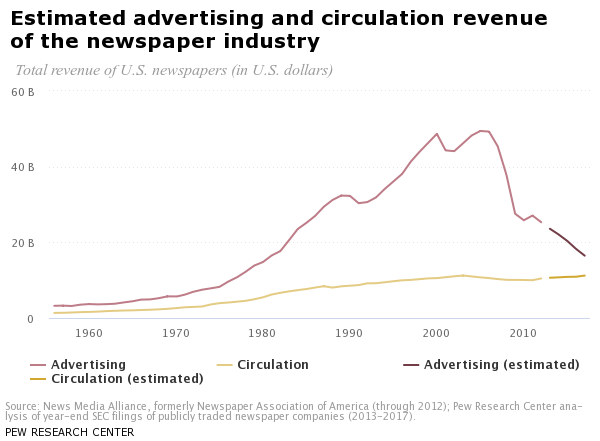I have a great fondness for journalism. The industry, the people, the organizations — it’s all fascinating and vitally important. My political and philosophical leanings lead me to believe that the tradition of having an independent and empowered Fourth Estate is key to a functioning democracy. Even in the absence of my politics and philosophies, reading the news is fun. I enjoy reading about the experiences of people I’ve never met going to places I’ve never been. How odd.
So to hear that the profession is dying, shrinking, or changing for the worse, and to listen to the narrative get increasingly louder is cause for some concern.
Now, this is by no means a new story – from 2005 onward the demise of the journalist has been a meta conversation for the industry. The timing correlates to when advertising revenues for newspapers began to decline at a rate the industry was not yet prepared for:

This chart, pulled from a recent Neimen Lab article about the rising cost of print subscriptions underscores a hard reality: Newspapers are businesses first. Like any business, a newspaper employees professionals, manages operating costs, and receives money from people interested in their product. When the bottom line changes, so too must the business. In this case, that means finding new ways to make money (enter digital subscriptions), raising prices on your existing product, and searching for a new business model entirely.
This third option (there can’t be a crazy third option, can there?) is where there is both the most opportunity and the most risk. Just ask the staff at Buzzfeed. In 2017, the company laid off 100 people after not meeting revenue goals, and last week announced a 15% reduction in staff as they struggle to meet the high expectations that come with a half billion dollars in funding under their belt.
The news of Buzzfeed layoffs comes amidst a variety of other layoffs from media companies. The Verizon Media Group (which operates Huffington Post, AOL, and Yahoo) announced that nearly 800 employees would be let go and Gannett (owners of USA Today along with hundreds of other local news organizations) continues to “let go” – a polite term for firing – journalists around the country.
Where does this leave the Fourth Estate? Is there a crazy fourth option? It’s something that the folks over at The Membership Puzzle, a project founded by Jay Rosen’s Studio 20 Program and the American arm of De Correspondent (The Correspondent), are asking. The project, set to run from 2017 to 2020, is searching for a sustainable path forward for journalism as digital media explodes and the pillars of the industry shift.
It’s something we should all be asking about if we have any interest in seeing the journalistic tradition continue. Newspapers aren’t just something to set down on your floor when you’re working on a DIY project – they’re the backbone of an informed citizenry. They provide context when context is needed. They keep communities together, talking, and engaged. It’s hard to undersell this; the decline of journalism is a crisis that we can’t ignore.